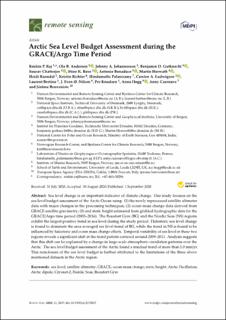| dc.contributor.author | Raj, Roshin Pappukutty | |
| dc.contributor.author | Andersen, Ole Baltazar | |
| dc.contributor.author | Johannessen, Johnny Andre | |
| dc.contributor.author | Benjamin, Gutknech | |
| dc.contributor.author | Chatterjee, Sourav | |
| dc.contributor.author | Rose, Stine | |
| dc.contributor.author | Bonaduce, Antonio | |
| dc.contributor.author | Horwath, Martin | |
| dc.contributor.author | Ranndal, Heidi | |
| dc.contributor.author | Richter, Kristin | |
| dc.contributor.author | Palanisamy, Hindumathi | |
| dc.contributor.author | Ludwigsen, Carsten | |
| dc.contributor.author | Bertino, Laurent | |
| dc.contributor.author | Nilsen, Jan Even Øie | |
| dc.contributor.author | Knudsen, Per | |
| dc.contributor.author | Hogg, Anna E. | |
| dc.contributor.author | Cazenave, Anny | |
| dc.contributor.author | Benveniste, Jérôme | |
| dc.date.accessioned | 2021-02-10T10:33:41Z | |
| dc.date.available | 2021-02-10T10:33:41Z | |
| dc.date.created | 2020-09-02T15:52:28Z | |
| dc.date.issued | 2020 | |
| dc.Published | Remote Sensing. 2020, 125, 2837 | en_US |
| dc.identifier.issn | 2072-4292 | |
| dc.identifier.uri | https://hdl.handle.net/11250/2727143 | |
| dc.description.abstract | Sea level change is an important indicator of climate change. Our study focuses on the sea level budget assessment of the Arctic Ocean using: (1) the newly reprocessed satellite altimeter data with major changes in the processing techniques; (2) ocean mass change data derived from GRACE satellite gravimetry; (3) and steric height estimated from gridded hydrographic data for the GRACE/Argo time period (2003–2016). The Beaufort Gyre (BG) and the Nordic Seas (NS) regions exhibit the largest positive trend in sea level during the study period. Halosteric sea level change is found to dominate the area averaged sea level trend of BG, while the trend in NS is found to be influenced by halosteric and ocean mass change effects. Temporal variability of sea level in these two regions reveals a significant shift in the trend pattern centered around 2009–2011. Analysis suggests that this shift can be explained by a change in large-scale atmospheric circulation patterns over the Arctic. The sea level budget assessment of the Arctic found a residual trend of more than 1.0 mm/yr. This nonclosure of the sea level budget is further attributed to the limitations of the three above mentioned datasets in the Arctic region. | en_US |
| dc.language.iso | eng | en_US |
| dc.publisher | MDPI | en_US |
| dc.rights | Navngivelse 4.0 Internasjonal | * |
| dc.rights.uri | http://creativecommons.org/licenses/by/4.0/deed.no | * |
| dc.title | Arctic Sea level Budget Assessment During the GRACE/Argo Time Period | en_US |
| dc.type | Journal article | en_US |
| dc.type | Peer reviewed | en_US |
| dc.description.version | publishedVersion | en_US |
| dc.rights.holder | Copyright 2020 by the authors | en_US |
| dc.source.articlenumber | 2837 | en_US |
| cristin.ispublished | true | |
| cristin.fulltext | original | |
| cristin.qualitycode | 1 | |
| dc.identifier.doi | 10.3390/rs12172837 | |
| dc.identifier.cristin | 1826857 | |
| dc.source.journal | Remote Sensing | en_US |
| dc.source.40 | 125 | en_US |
| dc.relation.project | Norges forskningsråd: 261743 | en_US |

